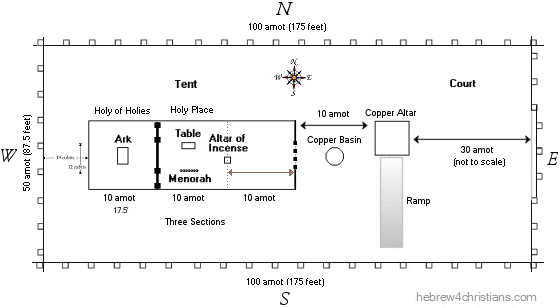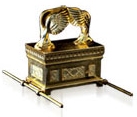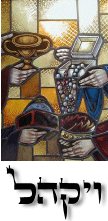|
This assembly occurred just after the first "Yom Kippur" (Tishri 10), after Moses descended the third time from Mount Sinai. Moses announced that even though Israel had so grievously sinned by worshipping the egel maseikhah (Golden Calf), God had forgiven them, and that the Shekhinah which had guided them through the wilderness would now abide with them in the holy Mishkan (Tabernacle).
Moses then went on to tell the people that the LORD called for a contribution (terumah) of gold, silver, bronze, and other materials for the construction of the mishkan and its furnishings. This was to be a free-will offering (nedavah LaAdonai) made by those "whose heart so moved him." The people responded with such alacrity that Moses finally had to restrain them from giving more! Moses then called for skilled craftsmen to come to assemble the mishkan and all its ritual objects.
The construction of the mishkan then began, with Betzalel and Oholiab leading the work. Note that Betzalel (betzal'el) is a type of Messiah, a man "called by name" from Judah who was "filled with the Spirit of God" (ruach Elohim) and whose name means "in the shadow of God." Betzalel's chief assistant is Oholiab (aholi'Av), a man from the tribe of Dan whose name means "the Father's tent."
The details of the construction of the Mishkan then are given: the curtains (yeriot) with their loops and clasps that would surround the tent-like structure; the covering (roof) of the mishkan made of goat's hair; the frames of acacia wood; and veil separating the holy place from the inner chamber (Holy of Holies). The Holy Ark (aron hakodesh) and Mercy Seat (kaporet), the Table (shulkhan) with the Bread of Presence (lechem ha-panim), the Menorah, the altar of incense (mizbach ha-ketoret) and altar of sacrifice (mizbach ha'olah) with its utensils, etc. The parashah ends with the description of the outer court. Interestingly, though the mishkan was assembled from so many different parts, it is said to be echad - a single unit.
Overview of the Tabernacle
The Mishkan would consist of two main parts: a tent-like structure called the ohel (אהֶל) and an outer court called the chotzer (חָצֵר). The tent was 30 amot long (52.5') and 10 amot wide (17.5') and was to be divided into two separate chambers. The innermost chamber was called the "Most Holy place" (קדֶשׁ הַקֳּדָשִׁים), measuring 10x10 amot, that would enclose the Ark of the Testimony (אֲרוֹן הָעֵדֻת). The Most Holy place was to be separated from an adjoining chamber (called the "Holy place") by means of an intricately woven curtain called the parochet. The Holy place was divided into two regions. In the region closest to the parochet were to be placed three special furnishings: a table of "showbread" (שֻׁלְחָן), a menorah (מְנוֹרָה), and an altar of incense (מִזְבַּח הַקְּטרֶת). The altar of incense (often called the Golden Altar) occupied the exact center of the Holy place. The outer court of the Mishkan measured 100 amot long (175') by 50 amot wide (87.5'). On the east side of the courtyard, 30 amot from the entrance, a copper altar was to be used for daily sacrifices. In addition, a copper water basin was to be used by the priests after performing their ministrations. The outer court was to be surrounded by a series of interconnecting posts held in place by silver sockets, from which curtains of blue, purple, and scarlet linen were to be hung. Here is a very simplified diagram of the layout:
 |
Notice that this is the second time that the description of the Mishkan and its furnishings is given in the Torah (the first time occurred in the previous Torah readings of Terumah, Tetzaveh and Ki Tisa). Why is this the case? For one thing, the LORD was showing that His purposes would not be thwarted, even if man's sin (i.e., the molten calf incident) causes a delay in God's perfect will. A second reason has to do with the fundamental importance of the Mishkan and the blood atonement rituals that allow for communion with God. God was trying to tell the Israelites that the way to come before Him was through the blood of a sacrificial victim, and this would ultimately be fulfilled in the Person of the Mashiach Himself. Finally, I think that the two descriptions speak of the two advents of the Mashiach Yeshua. In the first advent the Jews missed their opportunity for national atonement, but in the second advent they will be cleansed as a nation on the great Yom Kippur, when "all Israel shall be saved" by the One whom they rejected (as Joseph) but who is finally recognized as their true Deliverer.

Note: Rabbinical halakhah defines "work" (melakhah) as any of the categories of labor forbidden on the Shabbat. The Mishna (Shabbat) lists 39 prohibited tasks forbidden to do on Shabbat based on the actions necessary for the construction of the Mishkan. These 39 categories of work are called the Avot Melakhah, the "fathers" or primary categories, since they are considered the paradigm or the original source for all secondary types of melakhah which are similar and derived from them. This is a key concept in Talmudic Judaism.
What happened to the Ark?

According to various midrashim, Betzalel himself created the holy ark, which was later installed in the Bet Hamikdash (Temple of Solomon). Later, before the Temple was destroyed, Josiah (Yoshiyahu) hid it within the underground chambers of the Temple. When the Second Temple was built, it did not contain the ark, since no one could find it, though when the Messiah rebuilds the Temple in the latter days, it will be restored to the Kodesh Hakodeshim (Holy of Holies).
Haftarah Reading Snapshot:
The Haftarah of Parashat Vayakhel is about the first temple (bet hamikdash) that Solomon constructed. In particular, details about the temple furnishings made by King Hiram (of Tyre) on behalf of Solomon are detailed here.
Brit Chadashah Reading:
The Brit Chadashah reading first repeats the idea of "cheerful giving" that the children of Israel depicted when they gave their freewill offering for the construction of the mishkan. Next, the second reading (from 1 Corinthians) reminds us that Yeshua the Mashiach is the true foundation of the Temple, and we are "living stones" of which it is made up.
Blessing:
|






